A Guide to Choosing the Right Front Door for Different Climates
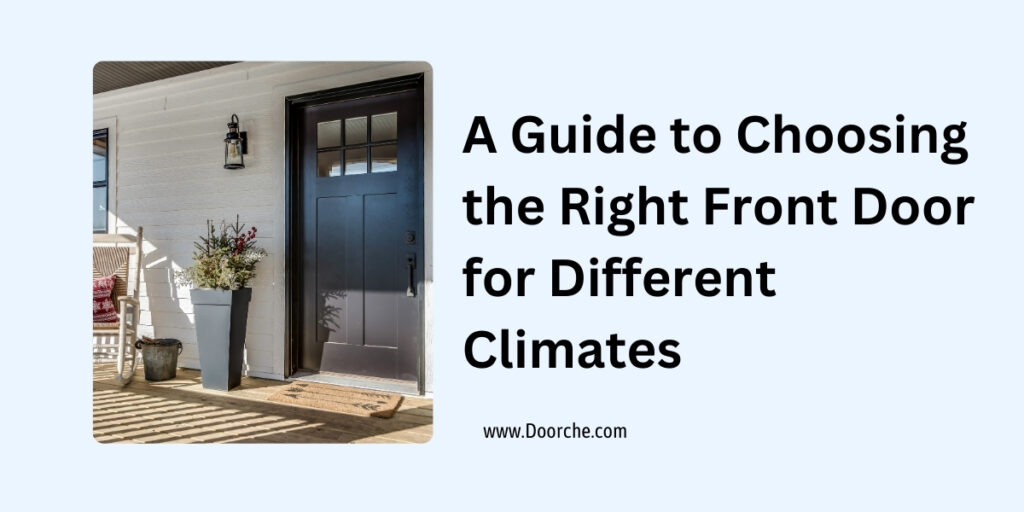
Choosing a front door is a big decision. It’s the first thing guests see and is crucial to both the security and durability of your home. If you live in an area with unique weather conditions, selecting the right door becomes even more important. Your entry door should be able to withstand the elements while maintaining its functionality and look. This guide will help you pick the perfect front door based on the climate in your area. Front Doors for Hot, Dry Climates In hot and dry regions, doors need to be able to resist intense heat and prolonged sun exposure. Such conditions can warp materials, fade finishes, and compromise durability over time. For these climates, it’s best to choose a door made from materials like metal with rust-resistant coatings or composite doors with UV protection. Steel or aluminum doors with anti-corrosion finishes can withstand extreme temperatures and resist sun damage, making them great choices for hot areas. If you prefer a wooden door in this climate, go for dense, hardwoods like oak or teak, and ensure it has a UV-protective coating. These finishes shield the wood from the sun and help prevent cracking, fading, or drying out due to the heat. Front Doors for Humid and Coastal Climates Humid and coastal climates present unique challenges for front doors. High humidity can cause materials to deteriorate quickly, leading to rust, warping, and swelling. For such environments, look for doors made of rust-proof materials like fiberglass, stainless steel, or treated aluminum. These materials are naturally resistant to water, keeping moisture from seeping in and damaging the door. Wood doors can be problematic in humid areas because they absorb moisture, leading to warping and decay. However, if you’re set on a wood door, make sure it’s well-sealed with a waterproof finish. Also, opt for corrosion-resistant hardware to protect locks and handles from rust in high-humidity environments. Front Doors for Cold and Snowy Regions For areas with cold, snowy winters, insulation is key. A well-insulated front door keeps heat inside, lowering energy bills and keeping your home cozy. Doors with foam-filled cores, fiberglass, or steel with thermal insulation layers are ideal for colder climates. These doors not only prevent heat loss but also stand up well to the temperature fluctuations that can cause materials to expand and contract. If you’re considering a wood door, make sure it’s made from durable hardwood and has insulation layers to help trap warmth and keep out the cold. Front Doors for Windy and Storm-Prone Areas If you live in an area prone to high winds or storms, your front door needs to be able to withstand these forces. Look for reinforced doors with strong frames and sturdy hinges. Fiberglass or steel doors with impact-resistant cores can hold up well under the pressure of strong winds and flying debris. In high-wind regions, multi-point locks provide added security, making it harder for the wind to push the door open. Doors with reinforced panels are also a smart choice, as they offer extra protection against potential impact. Key Considerations for Choosing Front Doors Based on Climate Considering these factors will ensure you choose a door suited to your specific climate. With the right front door, you protect your home and enhance its energy efficiency and curb appeal.
Sliding vs. Hinged Doors: Which is Better for Your Home?
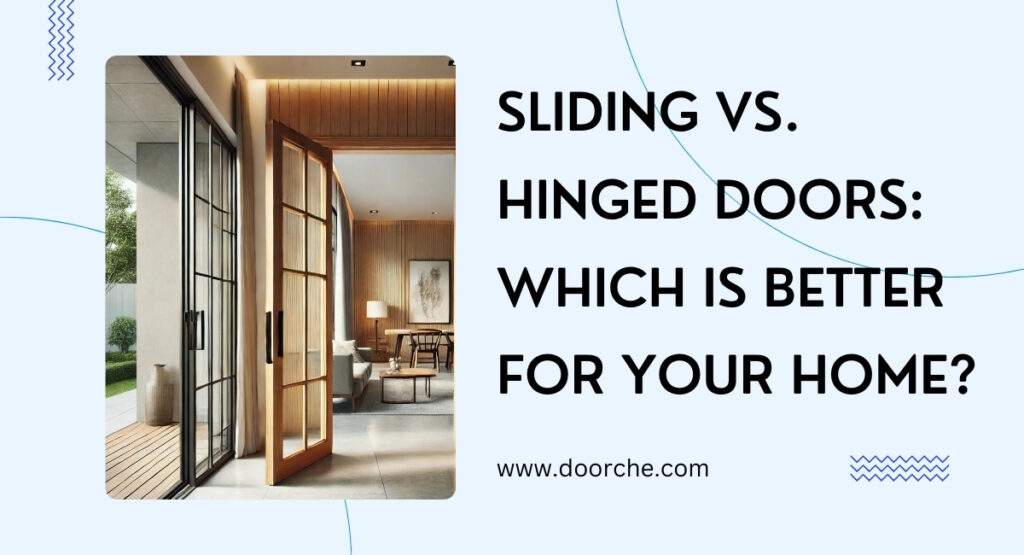
Choosing the right type of door for your home is one of the key decisions in interior design and renovation. Doors not only play a crucial role in functionality and aesthetics but also impact energy efficiency and even security. Two of the most popular door types used in homes are sliding doors and hinged doors. Each of these options has its own advantages and disadvantages, and depending on the specific needs of your space, one may be a better fit than the other. In this article, we’ll provide a comprehensive overview of these two types of doors and guide you toward making the best decision. Sliding Doors What Are Sliding Doors? Sliding doors are designed to move horizontally along a track, rather than opening inward or outward. These doors are commonly used in modern, small spaces, and in homes with patios, terraces, or balconies. A notable feature of sliding doors is the use of glass, which allows natural light to pass through and brighten the interior. Advantages of Sliding Doors: Space-SavingOne of the biggest advantages of sliding doors is their space-saving design. They do not require additional space for opening, making them ideal for rooms where space is limited. Compared to hinged doors, which take up internal or external space when opened, sliding doors move horizontally along the wall. More Natural LightSliding doors often feature large glass panels, which allow more natural light to enter the home. This is especially beneficial for rooms that face an outdoor area, as the use of glass makes the interior feel brighter and more open. Easy Access to Outdoor SpacesSliding doors are often used for entrances to patios, balconies, and terraces, providing easy access to the outdoor areas. Their smooth movement along the track makes them convenient for daily use and high foot traffic. Disadvantages of Sliding Doors: Need for Regular CleaningOne downside of sliding doors is that their tracks tend to accumulate dust and dirt, requiring regular cleaning. If the tracks are not properly maintained, the door’s movement may become less smooth. Lower InsulationDue to the use of glass and the gaps between the door and the frame, sliding doors may not provide the same level of insulation as hinged doors. This can lead to energy loss during hot or cold seasons unless the sliding doors are equipped with more advanced insulation technology. Less SecuritySliding doors, especially those with large glass panels, may offer less security than hinged doors. However, using reinforced glass and strong locking mechanisms can help mitigate this issue. Hinged Doors What Are Hinged Doors? Hinged doors are the traditional type of doors that are attached to a door frame with hinges and swing open either inward or outward. These doors have been widely used in homes for centuries and come in various designs and materials. Advantages of Hinged Doors: Better InsulationHinged doors typically provide better insulation than sliding doors due to their tighter seals and sturdier construction. This feature helps maintain indoor temperatures more effectively, reducing energy loss during cold or hot weather. Additionally, hinged doors can be made from materials that offer extra layers of insulation. Higher SecurityThanks to their solid construction and stronger locks, hinged doors generally offer better security compared to sliding doors. They can be equipped with multi-point locking systems and electronic locks, which significantly enhance the level of security. Variety in DesignHinged doors are available in a wide range of materials, including wood, metal, glass, and combinations of different materials. This variety allows you to choose doors that match the style and décor of your home. Disadvantages of Hinged Doors More Space Required for OpeningOne of the main drawbacks of hinged doors is the amount of space they need for opening and closing. This can be an issue in small spaces, especially when the door swings inward and takes up floor space. Traditional StyleHinged doors generally have a more traditional look, which might not suit homes with ultra-modern designs. However, there are modern designs of hinged doors available that can alleviate this issue to some extent. Final Comparison: Which Option Is Better? The choice between sliding and hinged doors ultimately depends on your specific needs. If space is limited and you want to maximize the available room, sliding doors may be the better option. They also provide easier access to outdoor spaces and allow more natural light into your home. On the other hand, if security and insulation are more important to you, hinged doors, with their stronger construction and tighter seals, maybe the right choice. Additionally, the design and style of your home play a crucial role in this decision. If you are looking for a minimalist and modern look, sliding doors might be more appealing. However, if you prefer a classic or versatile design, hinged doors offer a broader range of styles and materials. Conclusion In the end, the choice between sliding and hinged doors depends on various factors such as available space, insulation needs, security concerns, and your home’s overall design style. Both types of doors offer unique advantages that can be tailored to your home’s specific requirements. It’s recommended to carefully evaluate your needs and, if possible, consult with experts to make the best choice for your home.
Top Trends in Interior Doors for 2025

As we approach 2025, interior doors are evolving with new designs, materials, and technologies that cater to modern aesthetics and functional needs. Architects, interior designers, and homeowners alike are increasingly seeking out innovative solutions to enhance both the visual appeal and practicality of interior spaces. In this article, we explore the top trends in interior doors for 2025, highlighting key features that will define the interiors of tomorrow. Minimalist Door Designs for Contemporary Spaces In 2025, minimalism remains a significant trend in interior door design. Minimalist doors are known for their clean lines, simple hardware, and uncluttered surfaces. These doors are typically designed to blend seamlessly with the overall look of a room, offering a sleek and unobtrusive presence. Common finishes for minimalist doors include neutral colors such as white, black, and soft grays, which complement various interior styles. Hardware also plays a critical role in minimalist door designs. Concealed hinges and handle-less designs are gaining popularity, adding to the clean and continuous appearance of the doors. Minimalist doors create a sense of openness and allow the interior space to feel larger and more connected. Sliding Doors: A Space-Saving Solution Sliding doors, especially pocket doors, are emerging as a preferred option for homes that require space-saving solutions. As homeowners focus on optimizing every square meter of their living areas, sliding doors offer a practical yet stylish alternative to traditional hinged doors. These doors can slide into the wall cavity or along a track, making them perfect for small rooms, closets, and en-suite bathrooms. One of the standout features of sliding doors in 2025 is their ability to create an open, flowing feel in modern homes. Frameless glass sliding doors are particularly popular, as they allow natural light to move between spaces, enhancing the sense of brightness and airiness. These doors offer a contemporary touch while providing excellent functionality. Sustainability and Eco-Friendly Materials Sustainability is a growing concern in the construction and design industries, and interior doors are no exception. As we look ahead to 2025, there is a clear emphasis on eco-friendly materials and production processes. Homeowners and designers alike are opting for doors made from responsibly sourced wood, bamboo, or even recycled materials. The shift toward sustainability is not just about being environmentally conscious but also about creating healthier indoor environments. One popular choice is reclaimed wood doors, which repurpose old materials and offer a rustic, yet elegant, appearance. Bamboo doors are another eco-friendly option due to the plant’s rapid growth and minimal environmental impact. Additionally, manufacturers are incorporating low-VOC (volatile organic compounds) paints and finishes to ensure that these doors contribute to better indoor air quality. The Rise of Smart Interior Doors Smart home technology is expanding into every aspect of interior design, and in 2025, we will see the continued rise of smart interior doors. These doors are designed with advanced security features such as fingerprint scanners, keyless entry systems, and integrated sensors. Smart doors can also be connected to a home’s central automation system, allowing homeowners to lock, unlock, and monitor doors from their smartphones or tablets. While smart technology was traditionally used for exterior doors, 2025 will see its application in interior spaces as well. This trend is particularly prevalent in luxury homes, where convenience and security are top priorities. Smart interior doors offer not only enhanced security but also added convenience, making them a key trend to watch. Acoustic Doors for Privacy and Noise Reduction Privacy is an essential consideration in modern homes, especially in urban environments or homes with open floor plans. In 2025, acoustic doors designed to reduce noise transmission between rooms will gain significant traction. These doors are typically constructed with multiple layers of soundproofing materials, such as wood, metal, and insulation, to create an effective barrier against sound. Acoustic doors are ideal for home offices, bedrooms, or media rooms where privacy and noise control are essential. As more people work from home, the demand for soundproofing solutions has increased, making acoustic doors a must-have for homeowners seeking peace and quiet. Additionally, these doors are available in various designs, ensuring that aesthetics do not have to be compromised for functionality. Bold Colors and Unique Finishes While minimalist designs are still prevalent, 2025 will also see a rise in the use of bold colors and unique finishes for interior doors. Homeowners are increasingly using doors as focal points in their design schemes, choosing rich, saturated colors such as navy blue, emerald green, and deep charcoal. In addition to bold hues, expect to see more textured and tactile finishes in 2025. Matte, high-gloss, and textured surfaces are gaining popularity, adding a layer of visual and physical interest to interior doors. These finishes not only elevate the overall look of the door but also enhance the room’s decor. Custom finishes, such as metallic inlays or intricate patterns, will provide homeowners with the opportunity to create doors that reflect their personal style. Glass and Metal Combinations for a Modern Look The combination of glass and metal in interior door designs is set to be a defining trend in 2025. This pairing offers a sleek, modern aesthetic that fits well with contemporary interior spaces. Glass panels framed by slim metal borders provide an industrial yet elegant look, allowing light to flow between rooms without sacrificing privacy. Frosted or tinted glass is often used to balance the need for light transmission with privacy concerns, making these doors suitable for spaces such as home offices or bathrooms. Black metal frames, in particular, have become a hallmark of modern industrial design, offering a striking contrast against neutral or wooden surfaces. This blend of materials is perfect for both residential and commercial interiors. Conclusion Interior door design in 2025 is poised to reflect a balance between form and function, with an emphasis on sustainability, smart technology, and innovative aesthetics. Minimalist designs, space-saving sliding doors, and eco-friendly materials are just a few of the trends shaping the future of interior spaces. Additionally, bold colors, acoustic doors, and modern glass-metal combinations
The Best Insulated Doors for Energy Efficiency
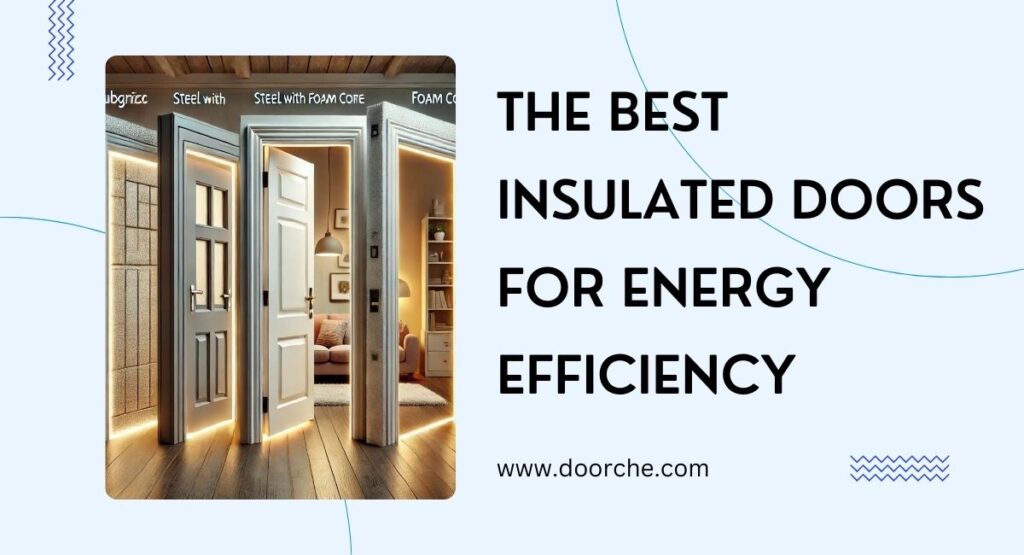
Energy efficiency is becoming an essential consideration in modern buildings, and one of the most effective ways to reduce energy consumption is by installing insulated doors. These doors play a crucial role in maintaining the internal temperature of buildings, reducing the need for heating and cooling, and lowering energy bills. In this article, we’ll explore the top insulated doors available, their materials, and how to choose the best option for your building. The Role of Insulated Doors in Energy Efficiency Doors are one of the main points where energy loss can occur in a building. Poorly insulated doors can lead to significant heat loss in winter and unwanted heat gain in summer. Insulated doors are designed to minimize these energy leaks by creating a thermal barrier between the interior and exterior environments. By investing in a quality insulated door, you can ensure a more comfortable indoor environment and save significantly on energy costs. Types of Insulated Doors Different materials and designs can greatly affect the insulation properties of doors. Each type of door offers unique benefits, depending on the specific needs of the building and the climate in which it is located. 1- Fiberglass Doors: Lightweight and Durable Fiberglass doors are becoming increasingly popular due to their light weight and high durability. They offer excellent thermal insulation, making them ideal for homes in regions with extreme weather conditions. Fiberglass is naturally resistant to moisture and temperature changes, which makes it one of the most energy-efficient materials for doors. Advantages: Disadvantages: 2- Steel Doors with Foam Core: Strength and Insulation Steel doors are known for their strength and durability, but when combined with a foam core, they become highly energy-efficient. The foam core acts as an insulator, reducing heat transfer through the door. These doors are commonly used in both residential and commercial buildings due to their ability to withstand extreme conditions while maintaining excellent insulation. Advantages: Disadvantages: Wooden Doors with Insulated Core: Aesthetic Appeal with Practical Benefits Wooden doors, particularly those with an insulated core, offer a combination of beauty and functionality. These doors provide good insulation properties while maintaining the natural, warm appearance of wood, making them a popular choice for traditional homes and buildings. Advantages: Disadvantages: uPVC Doors: Affordable and Efficient uPVC (unplasticized polyvinyl chloride) doors are one of the most cost-effective options for insulated doors. They are widely used due to their affordability and energy efficiency. These doors are also resistant to weathering and require minimal maintenance, making them ideal for both residential and commercial applications. Advantages: Disadvantages: Key Factors to Consider When Choosing Insulated Doors When selecting the best insulated door for energy efficiency, there are several factors to keep in mind: U-Value: The U-value measures the rate of heat transfer through the door. A lower U-value indicates better insulation performance. Look for doors with a low U-value to ensure maximum energy savings. Weather Resistance: Depending on the climate in your area, you may need a door that can withstand high winds, rain, or snow. Materials like fiberglass and uPVC are great for areas with harsh weather conditions. Sound Insulation: In addition to thermal insulation, some doors provide soundproofing benefits. This can be especially important if you live in a noisy area. Durability and Maintenance: Consider the long-term maintenance requirements of the door. Materials like steel and fiberglass tend to require less upkeep compared to wood, which may need regular sealing or painting to prevent damage. Tips for Optimizing Energy Efficiency with Insulated Doors Even the best-insulated door won’t perform well if it’s not installed properly. Here are a few additional tips to ensure optimal energy efficiency: Conclusion Investing in insulated doors is one of the most effective ways to enhance energy efficiency in your home or business. By understanding the different types of doors available, including fiberglass, steel, wood, and uPVC, you can choose the best option for your specific needs. Remember to consider factors such as U-value, weather resistance, and maintenance requirements when making your selection. Ultimately, insulated doors not only help you save on energy costs but also contribute to a more comfortable and environmentally friendly living or working space. For the best results, make sure to combine high-quality doors with proper installation and regular maintenance.
What is a minimalist room door?
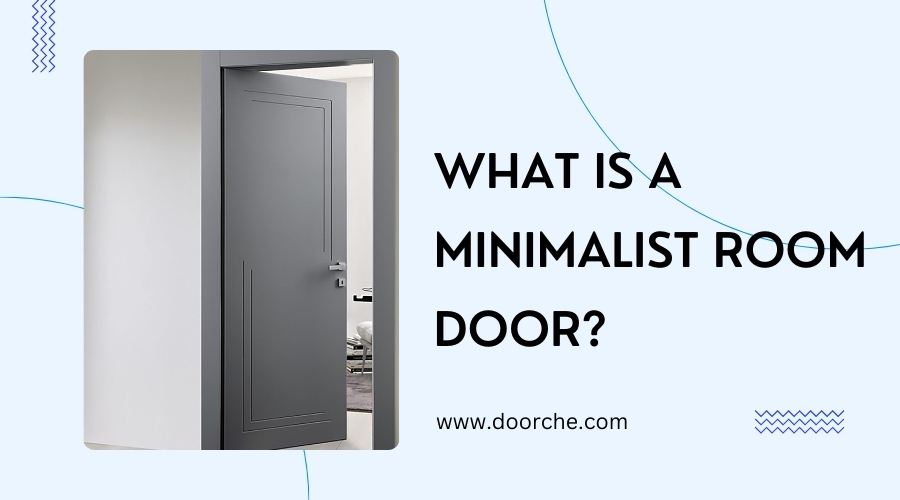
The expansion of urban life has led to numerous changes in the architectural styles of homes. Many homes, especially in large cities, are designed and built in a minimalist architectural style. The layout, interior decoration, and all internal aspects of these buildings also adhere to the minimalist style. Minimalist room doors are considered essential and foundational elements in the architecture of small homes. These doors will create a significantly different visual effect in interior decoration. Among the category of minimalist doors, Frameless doors are noteworthy. These types of doors are installed in homes or rooms with limited space. Frameless doors are doors whose frames or casings are entirely modern and attractively concealed. For this reason, they are also known as frameless doors or doors without frames. Are you aware of the characteristics of a minimalist room door? Not every door qualifies as a minimalist room door. These types of doors must synchronize with the minimalist architectural style. Among the hallmark features of minimalist doors, the following can be highlighted: 1. Simplicity and integrity In small spaces, the simplicity and serenity of layout and decoration play a highly effective role in creating an illusion of a larger room. This principle holds for minimalist room doors as well. Therefore, in designing these doors, simplicity and the absence of details will be of great importance. Due to their neutral colors and seamless integration with the walls and surrounding decor, these doors have garnered significant attention in modern small and minimalist-style homes. 2. Utilizing neutral colors in coloring A minimalist room door is typically painted in neutral colors such as white, gray, and… in a uniform and single color scheme. Simplicity in design and color is paramount in minimalist door aesthetics. 3. Use of special forms in design The minimalist style is considered a modern approach. In the design of minimalist doors, the use of simple, modern patterns, shapes, and lines is crucial for achieving a beautiful interior design and decoration. 4. Material type In the production of fantasy minimalist doors, materials with wood or other intricate designs are usually not utilized. These doors are influenced by the architectural style and interior decoration color and are crafted from materials with unique textures. For example, mirrored doors amplify the space’s light and visually enlarge its size. 5. Use of special accessories The handles and other accessories added to the door after production directly impact its aesthetic appeal. Minimalist room doors, due to their simplicity in design, are typically complemented with handles or protruding locks in non-neutral and attractive colors. The selection of these accessories’ models is as important as choosing the type of material, design, and color of the doors themselves. Conclusion: When choosing minimalist room doors, entrusting a professional and experienced team will make your purchase informed and enjoyable. Initially, carefully consider other interior decoration elements in your home or workspace when selecting the shape and color of the doors. The door should harmonize best with these arrangements to deliver a flawless and unique design for your interior space. Consulting with skilled and experienced designers and experts in this field is highly beneficial for selecting door designs and colors and ensuring an ideal purchase, leading to the best outcome.
What is a Polywood door?
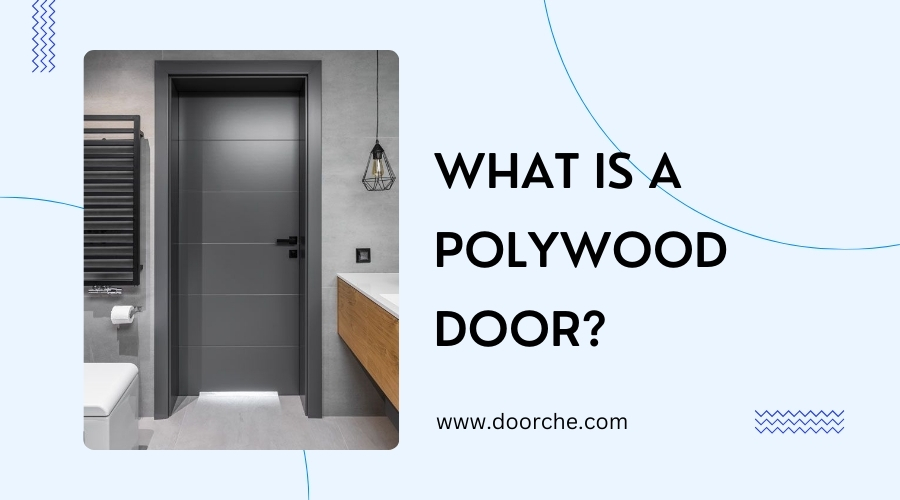
Polywood door is known as a class of waterproof doors. Due to their different interior structures, Polywood doors are more expensive than other kinds of doors. A combination of wood particles and polymer is used in its interior structure. The polymer makes the door waterproof. That’s why Polywood doors are best known for being used in bathrooms and toilets. What are the advantages and characteristics of Polywood doors? Factors affecting the price of Polywood doors The door and frame of Polywood cost less than Russian wood and MDF. This does not indicate a lower quality of the material, but the price differs due to the different structures of Polywood doors. It’s not the case of a price-quality relationship. Another significant fact about the price is the uniqueness of the foundation in the Plywood door structure. Compared to other kinds of waterproof doors, the structure provides you with the same price range and it doesn’t lead to an increased price. What about the size? Wood and polymer-made doors are manufactured in standard sizes as well as other doors. The sizes are regulated according to international standards to use them by the space available. Some important tips when you decide to buy Polywood doors It is important to take into account some tips before you decide to purchase Plywood doors. Some tips are suggested below: Ordering Polywood doors Source: polywood.org
Pivot doors
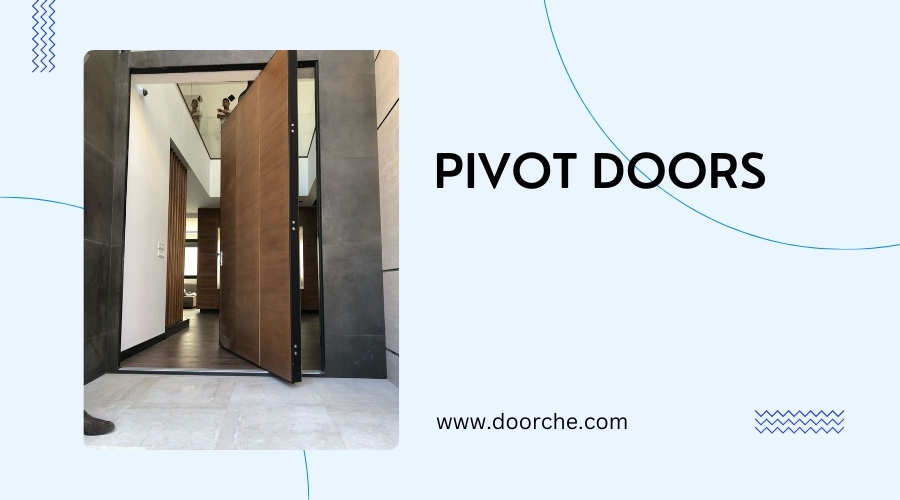
Pivot Doors: Elevate Your Space with Elegance and Functionality In the realm of modern home design, pivot doors have swiftly emerged as a stylish preference. Whether gracing the exterior or interior, these doors effortlessly infuse an unparalleled air of refinement and contemporary panache. For those seeking to make a statement upon arrival, exterior pivot doors stand as a chic choice. Meanwhile, within your living space, pivot doors seamlessly complement various settings. Yet, what precisely sets pivot doors apart? How do they operate, and what sets them ahead of the conventional hinged doors? This composition is poised to provide answers. Delve into the mechanics and advantages that pivot doors bring forth. Discover the array of pivot systems available. As you conclude, you’ll be empowered to ascertain whether pivot doors align harmoniously with your abode. The Unique Essence of Pivot Doors Hinged doors easily register with people due to their familiarity with everyday use. The concept involves two or three hinges affixed to one side of the door, enabling it to swing open and shut along these pivot points. However, pivot doors often leave an indelible impression on those encountering them for the first time. The initial astonishment stems from their distinct nature. Unlike hinged doors, pivot doors need not open from the very edge. They usually boast an offset configuration, placing the pivot point a few inches inward from the door frame. This ingenious setup allows the door to pivot open quite literally (with no conventional hinges in play). Remarkably, some pivot doors pivot at their midpoint, bestowing the entrance to the space with an enchanting aura reminiscent of a hidden passage. And let’s be honest, who wouldn’t relish the notion of a bedroom so secluded that it warrants a clandestine entrance? The Mechanics Behind Pivot Doors: How do they work? In stark contrast to hinged doors, which find their mobility governed by lateral hinges, a pivot door pivots around a solitary vertical axis known as a spindle. This innovative mechanism relies on a pair of pivot hinges: one affixed to the upper edge of the door and the frame’s header, and the other fastened to the door’s lower edge and the floor. The door gracefully rotates from a singular axis point by harnessing the power of these two pivot hinges. The strategic positioning of these pivot hinges within the entryway is variable, dictating the axis’s placement and effectively partitioning the entryway into two distinct zones when the pivot door stands ajar. When the hinge is situated a few inches away from the door’s side, it becomes the pivot door’s “tail” during its swinging motion. This configuration gives rise to an inward swing for an outward-pivoting door and an outward swing for an inward-pivoting door. This dual-directional movement not only fosters a modern aesthetic but also endows the door’s motion with a graceful, exquisite quality. Advantages of Opting for Pivot Doors Efficient Clearance Space: One notable advantage of choosing pivot doors over casement doors lies in their reduced need for clearance space during opening. The extent of this reduction is adjustable based on the placement of the pivot mechanism, catering to the requirements of each unique project. Concealed Outer Frames for a Streamlined Look: Many individuals favor the ability of pivot doors to conceal their outer frames within the building finishes, resulting in an ultra-minimalistic appearance. This design feature ensures that, when the door is open, there is no bulky outer frame to detract from the surrounding environment. Stylish Equal Framing: Pivot doors boast a sought-after design element—a symmetrical framing that encompasses the glass pane’s perimeter. This balanced and contemporary framing design is appealing to many discerning individuals. Support for Larger Sizes and Weights: Unlike casement doors with hinges on the side, pivot doors are attached to the building structure at the top and bottom. This unique setup enables pivot doors to accommodate greater sizes and heavier weights. The strategic weight distribution, coupled with engineered pivot mechanisms, allows these doors to support substantial glazing units, making them ideal for triple glazing and expansive structural openings. The minimal windows Pivot Door, for instance, has been tested at remarkable dimensions of up to 1.8m wide x 3m tall. Integrated Self-Closing Mechanisms: Many pivot doors seamlessly integrate self-closing and/or soft-closing mechanisms. This feature proves immensely valuable for individuals who tend to leave doors ajar or inadvertently slam them shut. Elegant Aesthetics with Invisible Hinges: Pivot hinges remain discreetly hidden on pivot doors, allowing the door’s design to take center stage, resulting in a captivating aesthetic. Material Versatility: Pivot doors can be crafted from various materials, provided the hinges can be mortised inside the door, granting architects and designers creative freedom. Support for Heavy and Large Doors: The placement of pivot hinges empowers architects to specify doors of substantial weight or generous size. The vertical weight distribution ensures stability, enabling pivot doors to even reach weights of up to 500 kgs when equipped with the appropriate pivot system. Ease of Installation: Whether for new constructions or renovations, pivot doors are user-friendly to install in a range of projects. The versatility of Applications: Pivot doors are equally adaptable for both interior and exterior applications, serving as harmonious additions to modern and contemporary architectural designs. Seamless Interior Integration: Frameless pivot doors can seamlessly blend with the interior architecture, creating a unified visual flow. Customizable Features: Pivot doors can be outfitted with various features, such as self-closing mechanisms, hold positions, damper control, and latch control, catering to diverse preferences. Effortless Operation: Regardless of their size and weight, the appropriate pivot hinge empowers easy, fingertip-operated opening and closing of pivot doors. Enhanced Security: Pivot doors offer elevated resistance against forced entry due to their lack of exposed hinges. Added Security Features: Pivot doors can further bolster security with the integration of multi-point locking systems, ensuring peace of mind. Incorporating pivot doors into your design brings forth an array of functional and aesthetic benefits, making them an appealing choice for a variety of architectural contexts. Varieties of Pivot Hinges:
Frameless interior doors

Frameless interior doors have emerged as a prominent trend in modern architectural design, offering a seamless blend of functionality and aesthetic appeal. Whether you’re an interior design enthusiast or a homeowner considering an upgrade, this article will provide valuable insights into the world of frameless interior doors. Frameless interior doors, also known as seamless or invisible doors, are revolutionary door systems designed to create a minimalist and contemporary look. Unlike traditional doors, frameless doors do not have a visible door frame or casing, presenting a sleek and streamlined appearance. The absence of a frame allows the door to seamlessly integrate with the surrounding walls, making it appear as an extension of the architecture itself. These doors are often made of premium materials such as glass, wood, or metal. Glass frameless doors, in particular, have gained immense popularity due to their ability to maximize natural light flow and create an open and airy ambiance. Frameless doors can be hinged or sliding, offering flexibility in terms of functionality and space optimization. The absence of a visible frame not only enhances the aesthetics but also eliminates potential visual obstructions, giving the illusion of a larger space. Benefits of Frameless Interior Doors Frameless interior doors offer several benefits that make them a popular choice for modern architectural design. Here are some key advantages: Costs of Frameless Interior Doors When considering frameless interior doors, it’s essential to understand the associated costs. Several factors influence the overall cost, including the type of material, size of the door, complexity of installation, and additional features or customization options. Here are some cost considerations: Material Costs: Frameless doors can be made from glass, wood, or metal, each with its own price range. Glass doors tend to be more expensive, especially if they require specialized glass types such as tempered or laminated glass. Size and Configuration: Larger or custom-sized doors may incur higher costs due to the additional materials and labor involved. Complex configurations like curved or multi-panel doors may also increase the overall cost. Installation Expenses: Professional installation is recommended for frameless doors to ensure proper fit and functionality. The cost of installation will vary depending on the complexity of the project and the contractor’s rates. Hardware and Accessories: The choice of hardware and accessories can impact the overall cost. Premium handles, locks, and other hardware options may increase the price, while basic options are more budget-friendly. Customization: Additional customization options, such as frosted or etched glass designs, decorative elements, or unique finishes, may incur additional costs. It’s important to obtain detailed quotes from reputable suppliers or contractors to accurately assess the costs of frameless interior doors for your specific project. Frameless Glass Doors Frameless glass doors are a popular choice among homeowners and designers for their ability to create a sense of openness and maximize natural light flow. These doors are made entirely of glass without visible frames or casings, offering a sleek and contemporary look. One of the main advantages of frameless glass doors is their ability to enhance the visual connection between different areas of space. They allow natural light to penetrate deep into interior rooms, creating a bright and airy atmosphere. Frameless glass doors can make smaller rooms appear larger and contribute to an overall sense of openness and spaciousness. Frameless glass doors come in various types, such as sliding, pivoting, or folding, offering flexibility in terms of functionality and design. Sliding glass doors are particularly popular for their smooth operation and space-saving benefits. In terms of aesthetics, frameless glass doors offer a seamless integration with the surrounding architecture, enhance natural light, and create a contemporary and elegant atmosphere. Whether used in residential or commercial settings, these doors can transform the look and feel of a space, bringing beauty, functionality, and a sense of openness. While glass is inherently fragile, frameless glass doors are constructed using tempered or laminated glass, which enhances their strength and safety. Tempered glass is highly resistant to impact and heat, making it less likely to shatter into sharp pieces if broken. Laminated glass consists of multiple layers with an interlayer, providing additional safety and sound insulation properties. Proper installation and sealing are crucial for frameless glass doors to ensure energy efficiency and maintain a comfortable indoor environment. Weatherstripping or gaskets are applied around the door perimeter to prevent drafts and minimize sound transmission. It’s important to note that privacy can be a consideration with frameless glass doors. However, there are options to address this concern, such as utilizing frosted or textured glass, adding blinds or curtains, or incorporating adjacent solid panels for privacy when needed. Frameless Wooden Doors While glass is a popular material choice for frameless interior doors, frameless wooden doors also offer a unique aesthetic and warmth to a space. These doors feature wooden panels without visible frames or casings, creating a seamless and natural look. Frameless wooden doors can be crafted from various types of wood, such as oak, walnut, or mahogany, offering versatility in terms of color, grain pattern, and texture. They can be left in their natural finish or stained to match the surrounding decor. One advantage of frameless wooden doors is their ability to provide sound insulation and privacy. Wood has inherent sound-absorbing properties, making these doors suitable for bedrooms, offices, or spaces that require noise reduction. The installation process for frameless wooden doors is similar to other frameless door types, involving careful measurements, wall modification if necessary, and the use of concealed hinge systems. Proper sealing and insulation are crucial to ensure energy efficiency and maintain a comfortable indoor environment. Frameless wooden doors are an excellent choice for those who prefer wood’s warmth and natural beauty while seeking a modern and minimalist design aesthetic for their interior spaces. Frameless Metal Doors In addition to glass and wood, frameless doors can also be made of metal, offering a unique and contemporary option for interior design. Frameless metal doors are known for their sleek and industrial aesthetic, making them a popular choice in modern and
